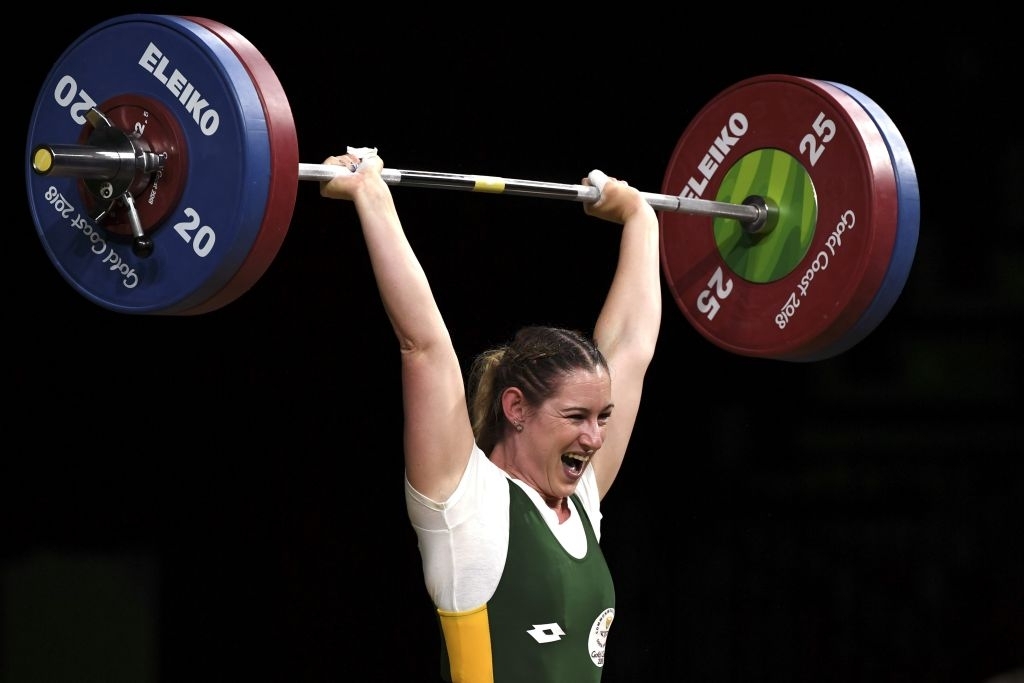Weightlifting is a sport of speed, strength, and power. The muscle snatch takes the strength portion to the next level. As the name states, it requires “muscling” the weight overhead rather than using a beautifully timed, fast explosive movement.
So why would you use the muscle snatch as a Weightlifter and how do you perform it?
Table of Contents
How To Perform The Muscle Snatch
The Starting Position
The starting position for the muscle snatch should be exactly the same as your snatch. Specifically having the bodyweight through the middle of the foot so you can push with the full foot.
Having your weight too far forward towards your toes will result in a lack of power when pulling and may cause the barbell to swing out in front. Weight that is too far back in the foot towards the heel then you may end up bumping the bar out in front to get the acceleration and extension during the second pull.
The barbell should cut the foot in half and be placed lightly against the shins with the shoulders over the bar. This is what coaches cite as being over the bar which you may have heard and is a position you will try to keep for as long as possible during the pull.
The lats need to be tight to keep the barbell close to the body. You can think about keeping tennis balls under the armpits in this position.
Create a big chest with the elbows facing out towards the plates. This big chest is facilitated by the head and eye position where the head should be facing forward and the eyes fixated on a spot above the head.
The slack must be taken out of the barbell while in this starting position. The slack of the barbell refers to the distance the bar moves without the plates leaving the ground.
If you don’t take the slack out of the bar, you will initiate the pull but the weights won’t move causing you to lose your position. Usually in the form of bringing the hips up too early.
Pulling the slack will allow you to get tight against the bar and initiate the pull with the weights coming off the floor as you push.
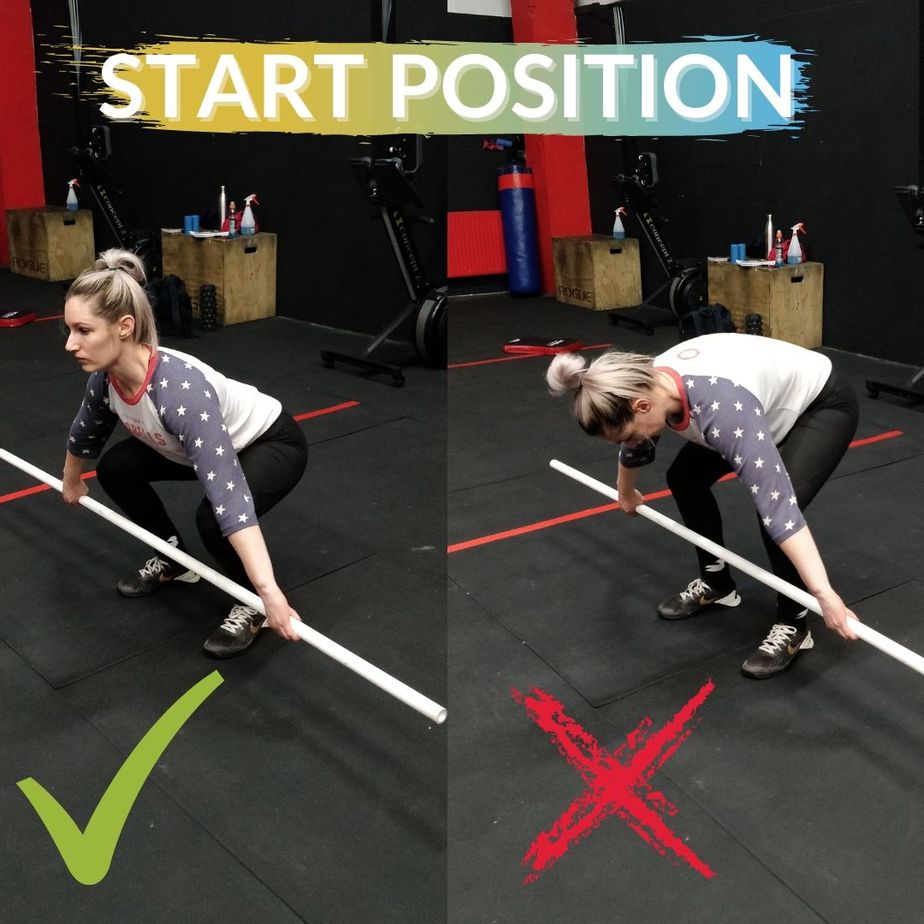
The Pull
As you push through the full foot against the floor, the back position should remain exactly the same as your starting position with the shoulders over the bar for as long as possible. Even past the knee.
If you lose this back angle and start to rise too early, then the only way to maximize the extension and acceleration of the bar is to pull back as you are already upright bumping the barbell in front.
Staying over the bar allows you to maximize the vertical extension and straight bar path.
The knees will be pushed back slightly for the bar to travel in a straight line. As the bar passes the knee, the barbell accelerates providing the explosive action of the second pull.
As you get to the hip, you will create a forceful triple extension of the hip, knee, and ankle along with a powerful shrug of the shoulders propelling the barbell vertically.
This is not a time to stop pulling the barbell which is a common mistake when performing the classical snatch as athletes will make hip contact and dive under the bar. Once hip contact is made with triple extension, the barbell must be pulled with the arms up the body like a snatch high pull.
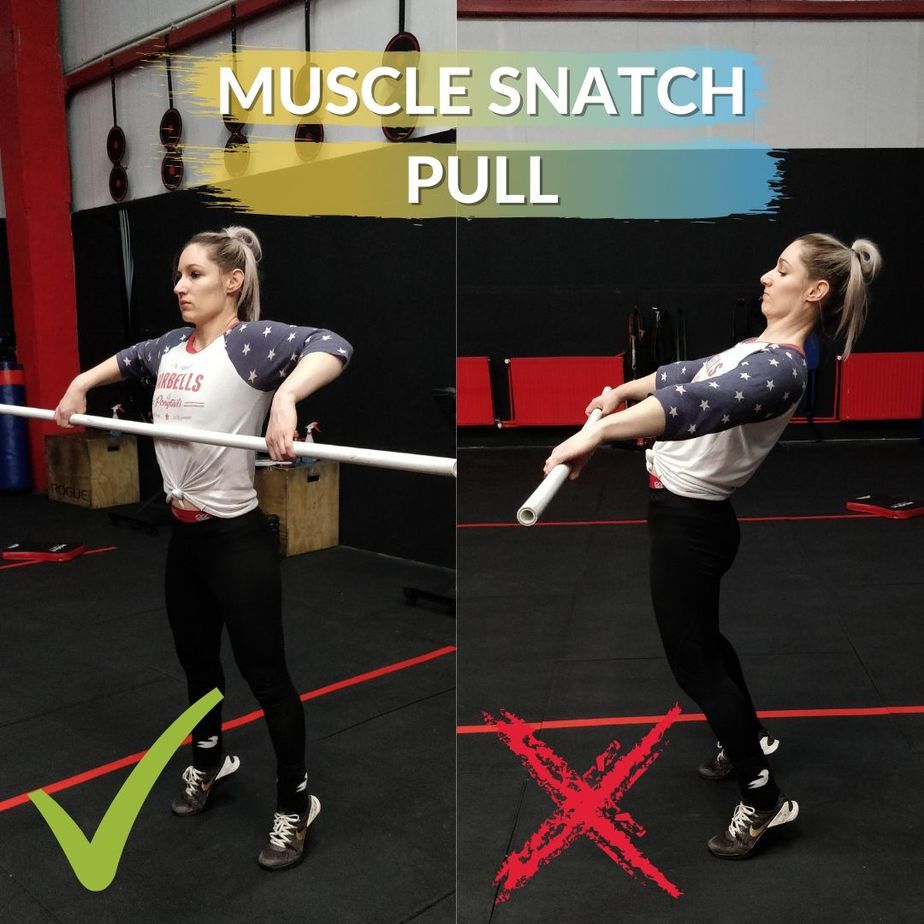
The Catch
As you continue to pull the bar upwards and overhead, the legs will remain straight. This is what makes the exercise a “muscle” variation. By keeping the legs straight, you are not able to re-bend the knees back under the bar.
Which means you have to pull the bar higher to the catch position. Once you reach the top of the pull with the barbell at chest level and the elbows high like a snatch high pull, you will continue pulling and will punch the barbell overhead.
The elbows should not drop from this high position. It should be a rapid turnover while keeping the elbows high.
The overhead position will have the head slightly forward to lock the barbell in a stable position where the biceps are in line with the ears.
The shoulder position overhead should not be internally or externally rotated which may fly against what some coaches teach.
An internally rotated shoulder points the elbows backward creating a forward shoulder position which can damage the shoulder and cause you to lose the bar forward.
An externally rotated shoulder points the elbows down which can add more stress on the elbows potentially causing pain.
The shoulders should sit naturally overhead with the elbows between these two positions.
Your wrists can either be extended or straight. This will be a personal preference with no real benefit or drawback for either technique.
For example, I like to have my wrists more neutral while my husband James, co-founder of RAWR Strength, likes to have this extended overhead.
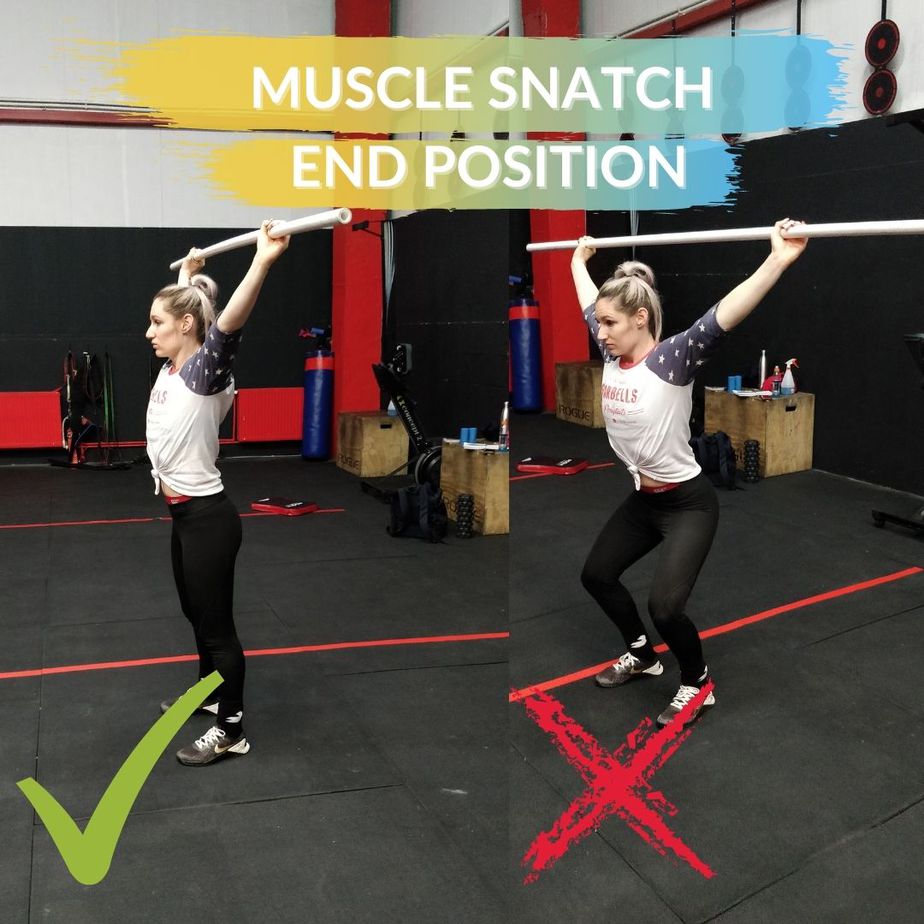
Why Use The Muscle Snatch?
Reinforce Correct Bar Path
With the classical snatch, you can sometimes get away with a poor bar path as the speed of the movement is so quick. The muscle snatch, because it is much slower, if the barbell doesn't stay close enough to the body or vertical enough, it will be near impossible to pull the bar overhead with the arms.
Forces The Triple Extension
Same as the bar path, cutting the pull short during the classical snatch is a common mistake that can still result in a successful lift. With the muscle snatch, it's almost impossible not to finish the pull and get a full triple extension as if you don't, the barbell won't budge much higher from the hips.
Strengthen The Arms And Shoulders
Because the legs remain straight, the arms and shoulders have to work harder to pull the bar higher. This is what makes the muscle snatch a specific strength exercise for the snatch.
However, the momentum from the floor means you can use more weight than you would during a muscle snatch variation from the hang.
Beginner Friendly
Beginner Weightlifters may find it difficult to pull themselves under the bar into a squat position. The muscle snatch allows a beginner to learn the snatch movement from the ground to overhead without going into a squat.
This can reinforce the correct technique while working on limiting factors such as squat mobility.
Provide Variety And Reduce Loading
Weightlifters don’t perform the same exercises all year round. At certain points throughout the year, more variation is programmed to reduce the overall loading and provide a different training stimulus.
The muscle snatch forces lighter loading reducing the overall stress on the body. Further, there is no foot movement reducing the impact with the platform.
When To Use The Muscle Snatch
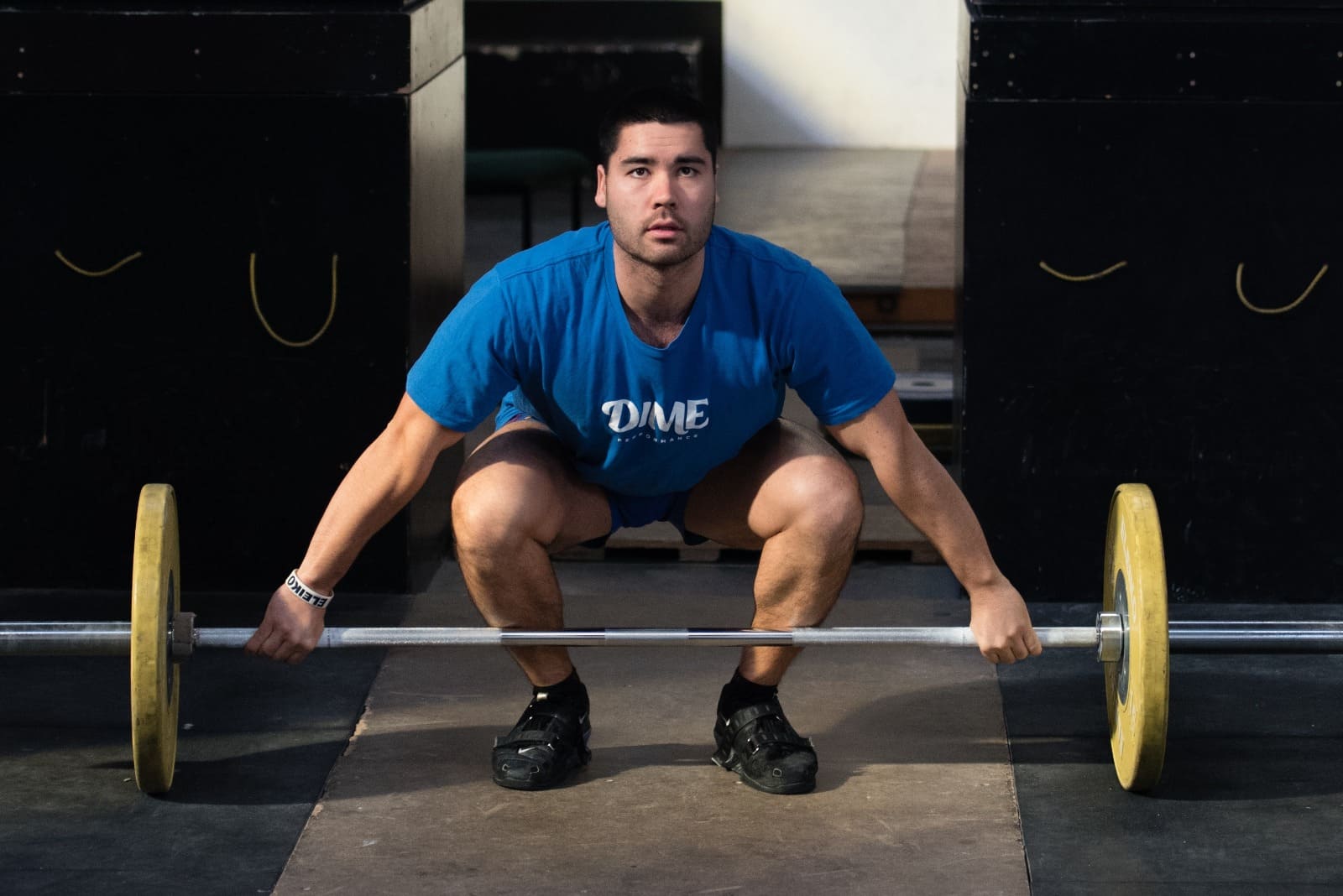
Most commonly the muscle snatch is used straight after competition or far away from a competition. As the lifter gets closer to competition, the muscle snatch is phased out for power or classical snatch variations.
Another use of the muscle snatch is to teach the beginner Weightlifter the movement of the snatch without having them move into a full squat pattern. This can reduce the complexity of the snatch potentially making it easier for a beginner to learn.
Finally, the muscle snatch is often used as a primer or warm-up before a snatch session to feel the push into the ground and getting full extension. Some Weightlifters will often perform their first one or two warm-up sets as muscle snatches before performing their snatch variation for that workout.
How Many Sets and Reps Of The Muscle Snatch?
Generally, the muscle snatch is programmed as 4-6 sets of 2-5 reps at 40-50% of your snatch 1RM. Because it is mainly a strength movement, higher volumes of 5 reps and lighter loads can be used without worrying about the degradation of technique.
Muscle Snatch Variations
No Hook Grip
The no hook grip is a common muscle snatch variation Weightlifters will use to place an even greater stress on the arms and grip. If looking to develop grip strength specifically for the snatch, this is an awesome variation to use.
No Contact
I like to have athletes make contact with the hip as they would with the classical snatch when performing the muscle snatch. However, some coaches like athletes to not make contact at all. This is often a personal preference. If you’re not sure, make contact like you would when snatching.
Hang Variations
The muscle snatch can be performed from many different hang positions such as the hang muscle snatch. The hang variations place greater stress on the upper body as you have less momentum generated from the legs.

